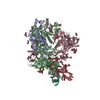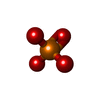[English] 日本語
 Yorodumi
Yorodumi- PDB-9d3d: Cryo-EM structure of PGT145 R100aS Fab bound to HIV-1 BG505 DS-SO... -
+ Open data
Open data
- Basic information
Basic information
| Entry | Database: PDB / ID: 9d3d | ||||||
|---|---|---|---|---|---|---|---|
| Title | Cryo-EM structure of PGT145 R100aS Fab bound to HIV-1 BG505 DS-SOSIP.664 Env trimer | ||||||
 Components Components |
| ||||||
 Keywords Keywords | VIRAL PROTEIN / HiV-1 / Vaccine / Fab / antibody / glycan / V2-apex | ||||||
| Function / homology |  Function and homology information Function and homology informationpositive regulation of plasma membrane raft polarization / positive regulation of receptor clustering / host cell endosome membrane / clathrin-dependent endocytosis of virus by host cell / viral protein processing / fusion of virus membrane with host plasma membrane / fusion of virus membrane with host endosome membrane / viral envelope / virion attachment to host cell / host cell plasma membrane ...positive regulation of plasma membrane raft polarization / positive regulation of receptor clustering / host cell endosome membrane / clathrin-dependent endocytosis of virus by host cell / viral protein processing / fusion of virus membrane with host plasma membrane / fusion of virus membrane with host endosome membrane / viral envelope / virion attachment to host cell / host cell plasma membrane / virion membrane / structural molecule activity / identical protein binding / membrane Similarity search - Function | ||||||
| Biological species |   Human immunodeficiency virus 1 Human immunodeficiency virus 1 Homo sapiens (human) Homo sapiens (human) | ||||||
| Method | ELECTRON MICROSCOPY / single particle reconstruction / cryo EM / Resolution: 3.41 Å | ||||||
 Authors Authors | Hodges, S. / Morano, N.C. / Shapiro, L. / Kwong, P.D. / Gorman, J. | ||||||
| Funding support |  United States, 1items United States, 1items
| ||||||
 Citation Citation |  Journal: Cell Rep / Year: 2025 Journal: Cell Rep / Year: 2025Title: Structural development of the HIV-1 apex-directed PGT145-PGDM1400 antibody lineage. Authors: Rosemarie D Mason / Baoshan Zhang / Nicholas C Morano / Chen-Hsiang Shen / Krisha McKee / Ashley Heimann / Renguang Du / Alexandra F Nazzari / Shelby Hodges / Tapan Kanai / Bob C Lin / Mark ...Authors: Rosemarie D Mason / Baoshan Zhang / Nicholas C Morano / Chen-Hsiang Shen / Krisha McKee / Ashley Heimann / Renguang Du / Alexandra F Nazzari / Shelby Hodges / Tapan Kanai / Bob C Lin / Mark K Louder / Nicole A Doria-Rose / Tongqing Zhou / Lawrence Shapiro / Mario Roederer / Peter D Kwong / Jason Gorman /  Abstract: Broadly neutralizing antibodies (bNAbs) targeting the apex of the HIV-1-envelope (Env) trimer comprise the most potent category of HIV-1 bNAbs and have emerged as promising therapeutics. Here, we ...Broadly neutralizing antibodies (bNAbs) targeting the apex of the HIV-1-envelope (Env) trimer comprise the most potent category of HIV-1 bNAbs and have emerged as promising therapeutics. Here, we investigate the development of the HIV-1 apex-directed PGT145-PGDM1400 antibody lineage and report cryo-EM structures at 3.4 Å resolution of PGDM1400 and of an improved PGT145 variant (PGT145-R100aS), each bound to the BG505 Env trimer. Cross-species-based engineering improves PGT145 IC breadth to near that of PGDM1400. Despite similar breadth and potency, the two antibodies differ in their residue-level interactions with important apex features, including N160 glycans and apex cavity, with residue 100i of PGT145 (sulfated tyrosine) penetrating ∼7 Å farther than residue 100i of PGDM1400 (aspartic acid). While apex-directed bNAbs from other donors use maturation pathways that often converge on analogous residue-level recognition, our results demonstrate that divergent residue-level recognition can occur within the same lineage, thereby enabling improved coverage of escape variants. | ||||||
| History |
|
- Structure visualization
Structure visualization
| Structure viewer | Molecule:  Molmil Molmil Jmol/JSmol Jmol/JSmol |
|---|
- Downloads & links
Downloads & links
- Download
Download
| PDBx/mmCIF format |  9d3d.cif.gz 9d3d.cif.gz | 439.9 KB | Display |  PDBx/mmCIF format PDBx/mmCIF format |
|---|---|---|---|---|
| PDB format |  pdb9d3d.ent.gz pdb9d3d.ent.gz | 364.8 KB | Display |  PDB format PDB format |
| PDBx/mmJSON format |  9d3d.json.gz 9d3d.json.gz | Tree view |  PDBx/mmJSON format PDBx/mmJSON format | |
| Others |  Other downloads Other downloads |
-Validation report
| Summary document |  9d3d_validation.pdf.gz 9d3d_validation.pdf.gz | 3.8 MB | Display |  wwPDB validaton report wwPDB validaton report |
|---|---|---|---|---|
| Full document |  9d3d_full_validation.pdf.gz 9d3d_full_validation.pdf.gz | 3.8 MB | Display | |
| Data in XML |  9d3d_validation.xml.gz 9d3d_validation.xml.gz | 66.2 KB | Display | |
| Data in CIF |  9d3d_validation.cif.gz 9d3d_validation.cif.gz | 97.8 KB | Display | |
| Arichive directory |  https://data.pdbj.org/pub/pdb/validation_reports/d3/9d3d https://data.pdbj.org/pub/pdb/validation_reports/d3/9d3d ftp://data.pdbj.org/pub/pdb/validation_reports/d3/9d3d ftp://data.pdbj.org/pub/pdb/validation_reports/d3/9d3d | HTTPS FTP |
-Related structure data
| Related structure data |  46532MC  9d1wC M: map data used to model this data C: citing same article ( |
|---|---|
| Similar structure data | Similarity search - Function & homology  F&H Search F&H Search |
- Links
Links
- Assembly
Assembly
| Deposited unit | 
|
|---|---|
| 1 |
|
- Components
Components
-Protein , 2 types, 6 molecules CABcab
| #1: Protein | Mass: 54086.324 Da / Num. of mol.: 3 / Fragment: UNP residues 30-505 Source method: isolated from a genetically manipulated source Source: (gene. exp.)   Human immunodeficiency virus 1 / Gene: env / Production host: Human immunodeficiency virus 1 / Gene: env / Production host:  Homo sapiens (human) / References: UniProt: Q2N0S6 Homo sapiens (human) / References: UniProt: Q2N0S6#2: Protein | Mass: 17146.482 Da / Num. of mol.: 3 / Fragment: residues 512-664 Source method: isolated from a genetically manipulated source Source: (gene. exp.)   Human immunodeficiency virus 1 / Gene: env / Production host: Human immunodeficiency virus 1 / Gene: env / Production host:  Homo sapiens (human) / References: UniProt: Q2N0S6 Homo sapiens (human) / References: UniProt: Q2N0S6 |
|---|
-Antibody , 2 types, 2 molecules HL
| #3: Antibody | Mass: 26323.240 Da / Num. of mol.: 1 Source method: isolated from a genetically manipulated source Source: (gene. exp.)  Homo sapiens (human) / Production host: Homo sapiens (human) / Production host:  Homo sapiens (human) Homo sapiens (human) |
|---|---|
| #4: Antibody | Mass: 23953.750 Da / Num. of mol.: 1 Source method: isolated from a genetically manipulated source Source: (gene. exp.)  Homo sapiens (human) / Production host: Homo sapiens (human) / Production host:  Homo sapiens (human) Homo sapiens (human) |
-Sugars , 8 types, 60 molecules 
| #5: Polysaccharide | 2-acetamido-2-deoxy-beta-D-glucopyranose-(1-4)-2-acetamido-2-deoxy-beta-D-glucopyranose Source method: isolated from a genetically manipulated source #6: Polysaccharide | Source method: isolated from a genetically manipulated source #7: Polysaccharide | Source method: isolated from a genetically manipulated source #8: Polysaccharide | beta-D-mannopyranose-(1-4)-2-acetamido-2-deoxy-beta-D-glucopyranose-(1-4)-2-acetamido-2-deoxy-beta- ...beta-D-mannopyranose-(1-4)-2-acetamido-2-deoxy-beta-D-glucopyranose-(1-4)-2-acetamido-2-deoxy-beta-D-glucopyranose Source method: isolated from a genetically manipulated source #9: Polysaccharide | Source method: isolated from a genetically manipulated source #10: Polysaccharide | alpha-D-mannopyranose-(1-2)-alpha-D-mannopyranose-(1-3)-[alpha-D-mannopyranose-(1-3)-alpha-D- ...alpha-D-mannopyranose-(1-2)-alpha-D-mannopyranose-(1-3)-[alpha-D-mannopyranose-(1-3)-alpha-D-mannopyranose-(1-6)]beta-D-mannopyranose-(1-4)-2-acetamido-2-deoxy-beta-D-glucopyranose-(1-4)-2-acetamido-2-deoxy-beta-D-glucopyranose | Source method: isolated from a genetically manipulated source #11: Polysaccharide | beta-D-mannopyranose-(1-3)-2-acetamido-2-deoxy-beta-D-glucopyranose-(1-4)-2-acetamido-2-deoxy-beta- ...beta-D-mannopyranose-(1-3)-2-acetamido-2-deoxy-beta-D-glucopyranose-(1-4)-2-acetamido-2-deoxy-beta-D-glucopyranose | Source method: isolated from a genetically manipulated source #12: Sugar | ChemComp-NAG / |
|---|
-Non-polymers , 1 types, 1 molecules 
| #13: Chemical | ChemComp-PO4 / |
|---|
-Details
| Has ligand of interest | N |
|---|---|
| Has protein modification | Y |
-Experimental details
-Experiment
| Experiment | Method: ELECTRON MICROSCOPY |
|---|---|
| EM experiment | Aggregation state: PARTICLE / 3D reconstruction method: single particle reconstruction |
- Sample preparation
Sample preparation
| Component | Name: PGT145 R100aS Fab with HIV-1 BG505 DS-SOSIP.664 Env trimer Type: COMPLEX / Entity ID: #1-#4 / Source: RECOMBINANT |
|---|---|
| Source (natural) | Organism:   Human immunodeficiency virus 1 Human immunodeficiency virus 1 |
| Source (recombinant) | Organism:  Homo sapiens (human) Homo sapiens (human) |
| Buffer solution | pH: 7.4 / Details: PBS |
| Specimen | Conc.: 4 mg/ml / Embedding applied: NO / Shadowing applied: NO / Staining applied: NO / Vitrification applied: YES |
| Specimen support | Grid material: COPPER / Grid type: C-flat-1.2/1.3 |
| Vitrification | Cryogen name: ETHANE |
- Electron microscopy imaging
Electron microscopy imaging
| Experimental equipment |  Model: Titan Krios / Image courtesy: FEI Company |
|---|---|
| Microscopy | Model: TFS KRIOS |
| Electron gun | Electron source:  FIELD EMISSION GUN / Accelerating voltage: 300 kV / Illumination mode: FLOOD BEAM FIELD EMISSION GUN / Accelerating voltage: 300 kV / Illumination mode: FLOOD BEAM |
| Electron lens | Mode: BRIGHT FIELD / Nominal defocus max: 2000 nm / Nominal defocus min: 800 nm |
| Image recording | Average exposure time: 2.5 sec. / Electron dose: 58.06 e/Å2 / Film or detector model: GATAN K3 (6k x 4k) / Num. of grids imaged: 1 |
- Processing
Processing
| EM software |
| ||||||||||||||||
|---|---|---|---|---|---|---|---|---|---|---|---|---|---|---|---|---|---|
| CTF correction | Type: PHASE FLIPPING AND AMPLITUDE CORRECTION | ||||||||||||||||
| Symmetry | Point symmetry: C1 (asymmetric) | ||||||||||||||||
| 3D reconstruction | Resolution: 3.41 Å / Resolution method: FSC 0.143 CUT-OFF / Num. of particles: 111484 / Algorithm: FOURIER SPACE / Symmetry type: POINT | ||||||||||||||||
| Atomic model building | Protocol: FLEXIBLE FIT |
 Movie
Movie Controller
Controller



 PDBj
PDBj








